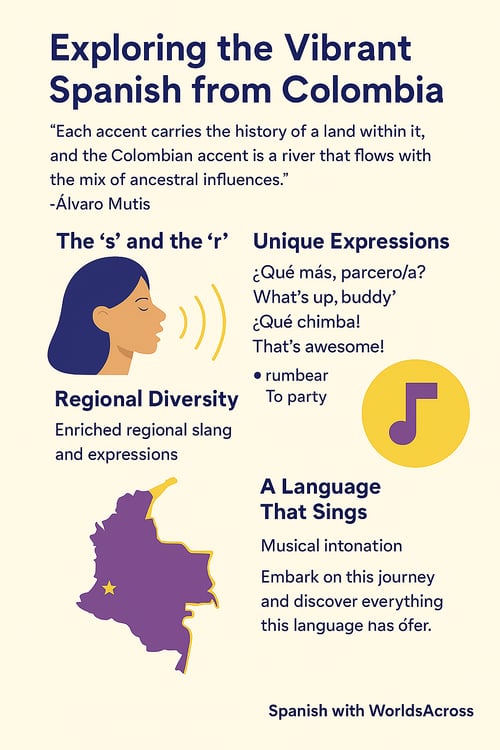Exploring the Vibrant Spanish from Colombia

“Language is not just a tool for communication, it is a homeland—and in Colombia, that homeland is built with words that reflect our diverse identity.”
—William Ospina
Colombian Spanish is much more than just a dialect; it’s a living expression of the country’s cultural richness and diversity. This variety of the language has been shaped by a mix of Indigenous, African, and Spanish influences that together have created a unique way of speaking. From the vibrant streets of Medellín to the beaches of Cartagena, the way people speak is known for its clarity, musicality, and colorful expressions that capture the soul of the country.
The Unique Sound of Colombian Spanish: The “s” and the “r”
You’ve probably been captivated at some point by the rhythms, tones, and accents of a Spanish speaker. One of the most charming features of Colombian Spanish is its phonetics. In regions like Bogotá, final consonants—especially the “s”—are clearly pronounced. In contrast, on the Caribbean coast, the “s” is often softened or dropped, giving the language a more melodic rhythm. This shift in sound makes listening to Colombian Spanish feel like a dance of words—precise and formal in some areas, relaxed and vibrant in others.
The “r” is another interesting example. While in many parts of Latin America the “r” can be strong and rolled, in Colombia—especially in Bogotá—it is softened, sounding closer to an “l.” These subtle differences are what give Colombian Spanish such a distinct and melodic accent.

Unique Expressions and Words
Colombian culture is full of expressions that not only enrich the language but also reflect the friendly and warm nature of its people. Here are some of the most common Colombian slang expressions:
- ¿Qué más, parcero/a? (What’s up, buddy?): Used as a friendly greeting.
Example: “¿Qué más, parcero? ¿Todo bien?” (What’s up, buddy? Everything good?) - ¡Qué chimba! (That’s awesome!): Expresses excitement or approval.
Example: “¡Qué chimba de concierto!” (That concert was awesome!) - Cucha/o (Mom/Dad): A casual way to refer to one’s parents.
Example: “Voy a almorzar donde mi cucha.” (I’m going to have lunch at my mom’s place) - Rumbear (To party): Used to talk about going out dancing or having fun.
Example: “Vamos a rumbear esta noche.” (We’re going to party tonight)
Regional Diversity
Colombia is a vast and varied country, and this is reflected in the diversity of its Spanish, enriched with regional slang and expressions. In Medellín and its surroundings, for example, the paisa accent is known for its melodic tone and use of diminutives—where chico becomes chiquitico. In contrast, on the Caribbean coast, people tend to speak more quickly and drop some consonants, adding an energetic flow to the language.
A Language That Sings
One of the most distinctive features of Colombian Spanish is its intonation. Speakers from the interior, especially in Bogotá, tend to have a more neutral and formal accent, while in regions like the coast, the intonation becomes more musical—almost like singing. This musicality reflects the joy and passion of the Colombian people, and listening to it makes it impossible not to feel the vibrant pulse of their culture.
As Gabriel García Márquez once said: “The Spanish language has an inner music that cannot be ignored. Every word is a universe, and the accent with which it is spoken completely changes its destiny.” This quote from the renowned Colombian writer captures the musical beauty of the country’s accent.
Learning Colombian Spanish is an enriching experience that goes far beyond mastering a dialect. It’s an invitation to dive into the culture of a vibrant country, to embrace its linguistic diversity and slang, and to understand the warmth and melody of its people. From its expressions to its pronunciation, we’ve given you a glimpse of Colombia—but there’s still so much more to discover!
“Each accent carries the history of a land within it, and the Colombian accent is a river that flows with the mix of ancestral influences.”
—Álvaro Mutis
Embark on this journey and discover everything this fascinating language has to offer!




